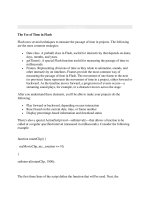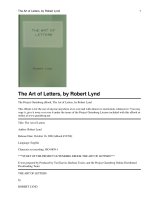Expanding the Use of time ppt
Bạn đang xem bản rút gọn của tài liệu. Xem và tải ngay bản đầy đủ của tài liệu tại đây (4.08 MB, 123 trang )
For More Information
Visit RAND at www.rand.org
Explore the Pardee RAND Graduate School
View document details
Support RAND
Browse Reports & Bookstore
Make a charitable contribution
Limited Electronic Distribution Rights
is document and trademark(s) contained herein are protected by law as indicated in a notice appearing
later in this work. is electronic representation of RAND intellectual property is provided for non-
commercial use only. Unauthorized posting of RAND electronic documents to a non-RAND website is
prohibited. RAND electronic documents are protected under copyright law. Permission is required from
RAND to reproduce, or reuse in another form, any of our research documents for commercial use. For
information on reprint and linking permissions, please see RAND Permissions.
Skip all front matter: Jump to Page 16
e RAND Corporation is a nonprot institution that helps improve policy and
decisionmaking through research and analysis.
is electronic document was made available from www.rand.org as a public service
of the RAND Corporation.
CHILDREN AND FAMILIES
EDUCATION AND THE ARTS
ENERGY AND ENVIRONMENT
HEALTH AND HEALTH CARE
INFRASTRUCTURE AND
TRANSPORTATION
INTERNATIONAL AFFAIRS
LAW AND BUSINESS
NATIONAL SECURITY
POPULATION AND AGING
PUBLIC SAFETY
SCIENCE AND TECHNOLOGY
TERRORISM AND
HOMELAND SECURITY
This product is part of the Pardee RAND Graduate School (PRGS) dissertation series.
PRGS dissertations are produced by graduate fellows of the Pardee RAND Graduate
School, the world’s leading producer of Ph.D.’s in policy analysis. The dissertation has
been supervised, reviewed, and approved by the graduate fellow’s faculty committee.
PARDEE RAND GRADUATE SCHOOL
Expanding the Use of
Time/Frequency Difference
of Arrival Geolocation in
the Department of Defense
Kimberly N. Hale
This document was submitted as a dissertation in September 2012 in partial
fulfillment of the requirements of the doctoral degree in public policy analysis at
the Pardee RAND Graduate School. The faculty committee that supervised and
approved the dissertation consisted of Brien Alkire (Chair), Carl Rhodes, and
Sherrill Lingel.
The RAND Corporation is a nonprofit institution that helps improve policy and
decisionmaking through research and analysis. RAND’s publications do not necessarily
reflect the opinions of its research clients and sponsors.
R
®
is a registered trademark.
The views expressed in this dissertation are those of the author and do not reflect the official policy or
position of the United States Air Force, Department of Defense, or the U.S. Government.
All rights reserved. No part of this book may be reproduced in any form by any
electronic or mechanical means (including photocopying, recording, or information
storage and retrieval) without permission in writing from RAND.
Published 2012 by the RAND Corporation
1776 Main Street, P.O. Box 2138, Santa Monica, CA 90407-2138
1200 South Hayes Street, Arlington, VA 22202-5050
4570 Fifth Avenue, Suite 600, Pittsburgh, PA 15213-2665
RAND URL:
To order RAND documents or to obtain additional information, contact
Distribution Services: Telephone: (310) 451-7002;
Fax: (310) 451-6915; Email:
The Pardee RAND Graduate School dissertation series reproduces dissertations that
have been approved by the student’s dissertation committee.
- iii -
A
BSTRACT
1
The U.S. Department of Defense (DoD) faces a tightening budget in
the coming years. Despite the lean budget years, unmanned aircraft
systems (UAS) are expected to be a priority. Secretary of Defense Leon
Panetta has pledged to maintain or even increase spending in critical
mission areas, such as cyber offense and defense, special operations
forces, and UAS (Shanker and Bumiller 2011). Due to their usefulness
for intelligence collection in irregular warfare (IW) and
counterinsurgency (COIN), UAS were quickly fielded and sent to theater
without analysis of how their intelligence sensors complemented each
other (Isherwood 2011). There are ways for DoD to improve the methods
of employment and the integration of multi-intelligence capabilities on
assets to better leverage the systems it currently owns.
The general aim of this research is to explore an area in which
DoD can operate “smarter” with its proliferating UAS fleet.
Specifically, this research investigates how DoD can better leverage
UAS and improve multi-intelligence capabilities by expanding its
geolocation capacity through the use of time/frequency-difference-of-
arrival (T/FDOA) geolocation on UAS. The research sheds light on
important questions that need to be answered before investing in
T/FDOA-capable UAS. I first demonstrate the potential of T/FDOA
geolocation in the context of how we use UAS today. I then show what
some of the “costs” of adding a T/FDOA geolocation capability to UAS
might be. Finally, I explore how T/FDOA geolocation could improve
multi-intelligence operations.
1
This manuscript was formatted assuming that the reader would have
access to a color copy. Interested readers who obtain a copy that is
difficult to read may contact the author at for
a color copy.
- iv -
S
UMMARY
The U.S. Department of Defense (DoD) faces a tightening budget in
the coming years. Despite the lean budget years, unmanned aircraft
systems (UAS) are expected to be a priority. Secretary of Defense Leon
Panetta has pledged to maintain or even increase spending in critical
mission areas, such as cyber offense and defense, special operations
forces, and UAS (Shanker and Bumiller 2011). Due to their usefulness
for intelligence collection in irregular warfare (IW) and
counterinsurgency (COIN), UAS were quickly fielded and sent to theater
without analysis of how their intelligence sensors complemented each
other (Isherwood 2011). There are ways for DoD to improve the methods
of employment and the integration of multi-intelligence capabilities on
assets to better leverage the systems it currently owns.
The general aim of this research is to identify and explore an
area in which DoD can operate “smarter” with its proliferating UAS
fleet by leveraging geolocation. Geolocation is the identification of
the physical location of an object. Specifically, this research
investigates how DoD can better leverage UAS and improve multi-
intelligence capabilities by expanding its geolocation capacity through
the use of time/frequency-difference-of-arrival (T/FDOA) geolocation on
UAS.
I focused on the geolocation of radio frequency (RF) emitters used
in a military context. There are several different techniques to
geolocate an emitter. This research investigates the use of T/FDOA
geolocation on UAS and sheds light on important questions that need to
be answered before investing in a T/FDOA capability for UAS.
To perform this research, I created a tool to estimate the
accuracy of T/FDOA geolocation to quantify its effectiveness. The
T/FDOA Accuracy Estimation Model takes a scenario for geolocation and
estimates the accuracy of the cooperative T/FDOA technique, including
the impact of various sources of errors. Quantifying the effectiveness
of T/FDOA geolocation allows this research to answer the proposed
research questions. Beyond the analysis in this dissertation, the tool
- v -
would be useful for assessing the dominant factors in T/FDOA
geolocation accuracy, which can inform decisions on choosing aircraft
orbit geometries to optimize performance, technology investment
decisions, and comparisons of the performance of T/FDOA with
alternative geolocation techniques for specific applications.
I first demonstrate the potential of T/FDOA geolocation in the
context of how we use UAS today to show what a signals intelligence
(SIGINT) system capable of T/FDOA would add. I contrast the T/FDOA
technique with direction finding, which is the common geolocation
technique used in the military today. T/FDOA geolocation is useful
against many targets, particularly those in an IW/COIN environment that
are difficult to geolocate using direction finding. Two of the major
drawbacks to T/FDOA are the need for multiple platforms and the
sensitivity to geometry. The drawbacks do not hinder employment of
T/FDOA as a secondary capability on UAS.
I then show some of the requirements of adding a T/FDOA
geolocation capability to UAS. Small changes are necessary to implement
T/FDOA on UAS. The technology for T/FDOA-capable sensors already
exists, and many UAS are nearly equipped to be capable. Today, one of
the largest drivers of manpower for UAS is the processing,
exploitation, and dissemination (PED) needed to turn the data collected
into actionable intelligence. The manpower and cost implications appear
to be small compared with the requirements to PED other sensors.
Finally, I explore how T/FDOA geolocation could improve multi-
intelligence operations. Adding a SIGINT with T/FDOA capability to UAS
instantly increases our ability to provide more information about
targets by layering complementing intelligence, surveillance, and
reconnaissance (ISR) sensors. T/FDOA geolocation provides high-accuracy
geolocation very quickly, reducing the time delay between intelligence
types and the area that a second intelligence, such as full-motion
video (FMV), would need to search. For command, control, and
communication (C3), the emerging ISR mission type orders (MTO) concept
meets the C3 needs for T/FDOA geolocation in complex operating
environments.
- vii -
C
ONTENTS
Disclaimer iii
Abstract iii
Summary iv
Contents vii
Figures ix
Tables xi
Acknowledgments xiii
Abbreviations xv
1. Introduction 1
Problem Statement 1
Motivation and Background 2
T/FDOA Implementation in the Military 9
Research Questions 11
Organization of the Dissertation 13
2. T/FDOA Accuracy Estimation Model 15
Measurement and Sources of Error 17
Problem Formulation 18
How the Tool Works 22
Examples of Tool 23
Example: Impact of Geometry 23
Example: Impact of Number of Receivers 25
Example: Impact of Measurement Errors 25
3. When Is T/FDOA Geolocation Useful? 29
A Contrast of Direction Finding and T/FDOA Geolocation 29
Types of Intelligence and Resulting Orbits 34
Missions Have a Primary Intelligence Focus 38
Scenario for Modeling Accuracies 38
Results from Orbit Geometries 42
Would UAS Operate Close Enough to Leverage T/FDOA? 45
Conclusion 51
4. What Is Needed to Use T/FDOA Geolocation? 53
Equipment for Platforms to Be Capable of T/FDOA Geolocation 53
Requirements for T/FDOA 54
AT3 System 54
UAS Integration 57
Manpower for PED 64
CONOPs, Organization, and Tasks 65
PED Within Platform Crew 67
PED Within DART 68
- viii -
Manpower and Costs Implications for Approaches 69
Conclusion 71
5. How Can T/FDOA Be Leveraged in Multi-Intelligence Operations? 73
Background for Multi-Intelligence Operations 73
Impact of T/FDOA Geolocation 74
Operation with Direction Finding versus T/FDOA Geolocation 74
Importance of Timing 76
Command, Control, and Communication 77
What C3 Is Needed for Multi-Intelligence Operations with
T/FDOA? 77
Using ISR MTOs 78
Conclusion 79
6. Conclusions and Recommendations 81
A. Direction Finding Model 85
Direction Finding 85
Theoretical Basis, the Stansfield Estimator 85
Errors 87
Model Implementation 88
B. Orbit Geometry Results 89
Scenario 1: Two Circular FMV Orbits 89
Scenario 2: One SAR, One Racetrack FMV 91
Scenario 3: SAR FMV 2 Cases Summary 93
Scenario 4: GMTI-FMV 1 Cases 95
Scenario 5: GMTI-FMV2 cases summary 97
C. CAP Allocation Model 100
D. Manpower Calculations 102
References 103
- ix -
F
IGURES
Figure 1.1 Aircraft Calculates LOBs along a Baseline 5
Figure 1.2 Signal May Have a Frequency Difference 6
Figure 2.1 Graphic Depiction of Tool Inputs and Outputs 16
Figure 2.2 Graph of TDOA and FDOA for Convexity Proof 20
Figure 2.3 Two Receiver Example with 1-Sigma Error Ellipse 24
Figure 2.4 Moving One Receiver for Poor Geometry 24
Figure 2.5 Adding a Receiver 25
Figure 2.6 Ellipse with Reduced Position Error 26
Figure 2.7 Ellipse with Reduced Velocity Error 26
Figure 2.8 Ellipse with Reduced Time Synchronization Error 27
Figure 3.1 Antenna Size vs Frequency 30
Figure 3.2 Time of Baseline impacts Direction Finding Accuracy 32
Figure 3.3 Range to Target Impacts Direction Finding Accuracy 33
Figure 3.4 SAR Requires a Straight Flight Path 35
Figure 3.5 GMTI Is Often an Elliptical Orbit 36
Figure 3.6 IMINT Does Not Dictate an Orbit 37
Figure 3.7 Racetrack Orbit for Road Surveillance and Circular Orbit for
360-degree Coverage of Compound 37
Figure 3.8 Operations Might Be in the same Area 39
Figure 3.9 Example of Geolocation Accuracies from Scenario 1 42
Figure 3.10 Histogram of Areas from Scenario 1 43
Figure 3.11 Results for 5 Scenarios: Percent Distribution of Error
Ellipse Areas 44
Figure 3.12 Example Coverage with 10 CAPS 46
Figure 3.13 Area Covered by Line of Sight as Altitude Increases 46
Figure 3.14 Area Covered as CAPs Increase 47
Figure 3.15 Coverage for 5, 10, 15, and 20 CAPs at 20,000ft 48
Figure 3.16 Average Percentage of Targets Without Line of Sight at
20,000ft 49
Figure 3.17 Results of Geolocations from 15kft 50
Figure 3.18 Results of Geolocations from 30kft 50
Figure 4.1 Geolocation Error Ellipse Can Be Influenced by Location of
GPS in Relation to Receiver 58
Figure 4.2 Size of Error Ellipse Increases as Position Error Increases59
- x -
Figure 4.3 Size of Error Ellipse Increases as Velocity Error Increases59
Figure 4.4 Typical Peak Data Rates for IMINT Sensors 60
Figure 4.5 Peak Data Rate as Urgency Requirement Changes 62
Figure 4.6 Peak Data Rate as Bandwidth Monitored Increases 63
Figure 5.1 Size of SIGINT Ellipse Impacts Time Needed to Find Target .75
Figure 5.2 Delay in Cross-cue Increases the Area Needed to Search 76
Figure A.1 Aircraft Calculates LOBs Along a Baseline 85
Figure A.2 Graphical Depiction of Direction Finding Model 88
Figure B.1 Example of Scenario 1: Two Circular FMV Orbits 90
Figure B.2 Histogram of Scenario 1 Error Ellipse Areas 90
Figure B.3 Example of Scenario 2: One SAR, One Racetrack FMV 92
Figure B.4 Histogram of Scenario 2 Error Ellipse Areas 92
Figure B.5 Example of Scenario 3: One SAR, One Circular FMV 94
Figure B.6 Histogram of Scenario 3 Error Ellipse Areas 95
Figure B.7 Example of Scenario 4: One GMTI, One Racetrack FMV 96
Figure B.8 Histogram of Scenario 4 Error Ellipse Areas 97
Figure B.9 Example of Scenario 5: One GMTI, One Circular FMV 98
Figure B.10 Graph of Scenario 5 Error Ellipse Areas 99
Figure C.1 CAP Model 100
- xi -
T
ABLES
Table 1.1 Geolocation Contribution to Intelligence Tasks 3
Table 1.2 Summary of Pros and Cons of Geolocation Techniques 7
Table 2.1 Data for Error Model 18
Table 3.1 Line of Sight Limitations 40
Table 3.2 Scenarios for Orbit Geometries 40
Table 3.3 Orbit Inputs 41
Table 3.4 Other Model Parameters held Constant 41
Table 4.1 System Parameters 53
Table 4.2 AT3 Sensor System 55
Table 4.3 UAS FMV Mission Crew Positions 67
Table 4.4 Manpower for T/FDOA PED 69
Table 4.5 Costs for Manpower for T/FDOA PED in $100,000 70
Table 5.1 Intelligence Types Provide Different Information About the
Target 73
Table B.1 Orbit Parameters for Scenario 1 89
Table B.2 Orbit Parameters for Scenario 2 91
Table B.3 Orbit Parameters for Scenario 3 93
Table B.4 Orbit Parameters for Scenario 4 95
Table B.5 Orbit Parameters for Scenario 5 97
- xiii -
A
CKNOWLEDGMENTS
This research was supported by funding from RAND Project AIR FORCE
(PAF) and the RAND National Defense Research Institute’s Acquisition,
Technology, and Logistics Policy Center. I would like to thank my
dissertation committee, Brien Alkire (chair), Carl Rhodes, and Sherrill
Lingel, as well as Sarah Robinson for acting as the outside reader. I
received help and advice from many outside of my committee, including
Natalie Crawford, Ray Conley, and Col Mark Braisted. Asha Padmanabhan
was instrumental in connecting me with contacts within the Air Force. I
would like to thank the members of the 163rd at March Air Reserve Base,
especially DeltaFox and others around the Air Force that have given me
their insights. Finally, I am very grateful to my family and friends
for supporting me throughout these three years.
- xv -
A
BBREVIATIONS
AOA angle of arrival
AT3 Advanced Tactical Targeting Technologies
BAMS Broad Area Maritime Surveillance
C2 command and control
C3 command, control, and communication
CAN correlation analyst
CAOC Combined Air Operations Center
CAP combat air patrol
CEP circular error probable
CONOPs concept of operations
DARPA Defense Advanced Research Projects Agency
DART DCGS Analysis and Reporting Team
DCGS Distributed Common Ground System
DIRLAUTH direct liaison authority
DoD U.S. Department of Defense
EIRP effective isotropic radiated power
EO electro-optical
FDOA frequency difference of arrival
FMV full-motion video
GEOINT geospatial intelligence
GMTI ground moving target indicator
HF high frequency
HUMINT human intelligence
HTS R7 Harm Targeting System Revision 7
IA imagery analyst
IED improvised explosive device
IMINT imagery intelligence
IMS imagery mission supervisor
INS Inertial Navigation System
IR infrared
IRE Imagery Report Editor
ISR intelligence, surveillance, and reconnaissance
- xvi -
ISRD ISR Division
JTIDS Joint Tactical Information Distribution System
LOB line of bearing
MASINT measurement and signature intelligence
MOC mission operations commander
MP mission planner
MSA multi-source analyst
MTO mission type order
NASIC National Air and Space Intelligence Center
NIB non-interference basis
OSINT open-source intelligence
PLLS Precision Location and Strike System
SAM surface-to-air missile
SAR synthetic aperture radar
SATCOM satellite communication
SIDO senior intelligence duty officer
UHF ultra high frequency
PED processing, exploitation, and dissemination
QDR Quadrennial Defense Review
RF Radio Frequency
SATCOM satellite communication
SIGINT signals intelligence
SWAP size, weight, and power
SNR signal-to-noise ratio
TDOA time difference of arrival
UAS unmanned aircraft systems
VHF very high frequency
- 1 -
1.
INTRODUCTION
P
ROBLEM STATEMENT
The U.S. Department of Defense (DoD) faces steep budget declines
over the next decade. Military acquisition and research, development,
test, and evaluation will likely be the hardest hit by spending cuts
(Eaglen and Nguyen 2011). Despite the lean budget years, unmanned
aircraft systems (UAS) are expected to be a priority. Secretary of
Defense Leon Panetta has pledged to keep the spending constant or even
increase spending in critical mission areas, such as cyber offense and
defense, special operations forces, and UAS (Shanker and Bumiller
2011). As part of the plus-up to fight the wars in Afghanistan and
Iraq, DoD invested heavily in UAS for intelligence, surveillance, and
reconnaissance (ISR). The result was quickly fielding and sending to
theater complex systems. The UAS inventory surged from 163 in February
2003 to over 6,000 today (Bone and Bolkcom 2003; Kempinski 2011). These
UAS were rapidly amassed and employed, with very little analysis of how
the different ISR sensors complemented each other (Isherwood 2011).
There are ways for DoD to improve the methods used to employ UAS and
the integration of multi-intelligence capabilities on assets to better
leverage the systems it currently owns. The general aim of this
research is to identify and explore one area in which DoD can operate
“smarter” with its proliferating UAS fleet by leveraging geolocation.
Geolocation is the identification of the physical location of an
object. This research focuses on a method of employment coupled with
small technological changes that can significantly improve the
geolocation capabilities of DoD.
Specifically, this research investigates how DoD can better
leverage UAS and improve multi-intelligence capabilities by expanding
its geolocation capacity through the use of time/frequency-difference-
of-arrival (T/FDOA) geolocation on unmanned assets. This advancement in
geolocation would improve several aspects of ISR. It would increase the
hunting ability for UAS, which are often termed hunter-killer
platforms, potentially shortening the kill chain. Focusing on ISR,
- 2 -
improved geolocation would enable better cross-cueing between platforms
or self-cueing on multi-intelligence platforms, creating a richer
intelligence picture. Incorporating T/FDOA geolocation would require
changes. A new concept of operation (CONOP) needs to be developed for
the execution of T/FDOA from ISR platforms and the incorporation of
multi-intelligence sources. Payload modifications, though hypothesized
to be modest, need to be quantified. The impacts on the processing,
exploitation, and dissemination (PED) process also need to be evaluated
to determine the efficacy of this concept. This research is intended to
inform DoD policy by showing that an expanded use of T/FDOA geolocation
on UAS would improve multi-intelligence capabilities.
M
OTIVATION AND BACKGROUND
The 2010 Quadrennial Defense Review (QDR) stresses the importance
of increased ISR to support the warfighter. The QDR articulates several
priorities involving the growth of ISR, including expansions of the
“intelligence, analysis, and targeting capacity” and of “unmanned
aircraft systems for ISR” (Department of Defense 2010). The Unmanned
Systems Integrated Roadmap FY2009-2034, published by the Office of the
Under Secretary of Defense for Acquisition, Technology, and Logistics,
outlines priorities for future investment in unmanned systems and
echoes similar themes. The top two priorities for future investments in
UAS are improvements in reconnaissance and surveillance, particularly
multi-intelligence capable platforms, and improvements in target
identification and designation, including the ability to precisely
geolocate military targets in real time (Under Secretary of Defense for
Acquisition, Technology, and Logistics 2009).
Geolocation is the identification of the physical location of
objects on the earth. The term is used to refer to both the action of
locating and the results of the localization. There are numerous ways
to accomplish geolocation. This research focuses on the geolocation of
radio frequency (RF) emitters used in a military context. Geolocation
of RF emitters is critical to a wide variety of military applications.
In conflicts, geolocation is vital for both targeting and situational
awareness. RF emitters of interest range from elements of an integrated
- 3 -
air defense system and communications nodes in a major combat operation
to insurgents communicating with push-to-talk radios. A key difference
in military geolocation is the non-cooperation of targets. An enemy
usually attempts to disguise emissions using evasive techniques that
complicate geolocation. For example, the time of transmission might not
be known. The military uses signals intelligence (SIGINT) to take
advantage of the electromagnetic emissions intercepted from targets.
These electromagnetic emissions can provide information on the
intention, capabilities, or location of adversary forces (AFDD 2-0).
Many intelligence tasks depend on geolocation; however, each task
does not require the same level of accuracy. Table 1.1 summarizes
specific intelligence tasks requiring geolocation, comments on the
value of geolocation, and gives an idea of the accuracy needed.
Although these accuracies are intended to be ballpark figures, they
highlight the need for significant accuracy for certain tasks, such as
precision location.
Table 1.1
Geolocation Contribution to Intelligence Tasks
Objective Value Accuracy
Needed
Weapon sensor location
(self-protection)
Allows threats to be avoided
or negated through jamming
Low
(5km
2
)
Emitter differentiation Allows sorting by location
for separation of threats for
identification processing
Enemy asset location Allows narrowed
reconnaissance search
Medium
(1km
2
)
Electronic order of battle Locate emitter types
associated with specific
weapons/ units. Provides
information on enemy
strength, deployment, etc.
Weapon sensor location Allows threat to be avoided
by other friendly forces
Precision target location Allows direct attack High
(100m
2
)
SOURCE: Table adapted from Adamy, D. (2001). EW 101. Boston, Artech
House. p. 144.
- 4 -
There are several techniques currently used to geolocate an RF
emitter. These techniques include using the angle of arrival (AOA) of
the emission, using coherent time-difference-of-arrival (TDOA) at a
single platform, using non-coherent TDOA for the emission to multiple
receivers, and using the frequency-difference-of-arrival (FDOA) for the
emission to multiple receivers. Each of the techniques depends on
precise measurements. Errors in the accuracy of the measurements impact
the accuracy of geolocation, resulting in some amount of error inherent
in the geolocation.
The errors involved and the impact on the accuracy of the
geolocation depend on the technique used. These errors include such
things as positioning errors (how well the aircraft knows its own
position), signal measurement errors (how well the receiver can capture
the received signal), and noise inherent in the signal. To reduce
error, techniques can be combined and used together, for example T/FDOA
geolocation leverages both TDOA and FDOA to determine position more
accurately. Regardless of the system used, the geolocation accuracy is
dependent on the accuracy of the chosen technique and how the SIGINT
system is designed to minimize error (Adamy 2001).
The military traditionally uses direction finding, also known as
triangulation, to fix the position of an emitter using specialized
manned aircraft. In direction finding, an aircraft would measure the
AOA at multiple locations along a baseline to create lines of bearing
(LOBs) between the receiver and the emitter. Two or more LOBs enable
the emitter to be fixed at the intersection of these different LOBs.
Figure 1.1 depicts a pictorial of direction finding. Single-receiver
direction finding requires one receiver to measure the signal at one
position and then move and re-measure the same signal. Multi-receiver
direction finding requires at least two geographically separated
receivers collecting LOBs on the same target. There are many algorithms
available to calculate the emitter location. These range from plotting
LOBs on a common map to calculations based on statistical techniques
such as least-squares error estimation and the discrete probability
density method (Poisel 2005).
dire
c
dire
c
emis
s
not
s
enab
l
at l
e
In T
D
rece
i
rece
i
the
s
the
d
diff
e
show
s
pote
n
of t
h
posi
t
There ar
e
c
tional a
n
c
tion fin
d
s
ion as w
e
s
ubject t
o
Cooperat
i
l
e receiv
e
e
ast two
r
D
OA, the
d
i
vers is
p
i
vers fro
m
s
hape of
a
d
ifferenc
e
e
rence in
s
a picto
r
n
tial sou
r
h
e signal
t
ion of t
h
e
limitati
o
n
tenna, wh
i
d
ing can b
e
e
ll as tar
g
o
these li
m
Aircraf
t
i
ve T/FDOA
e
rs to qui
c
r
eceivers
a
d
ifference
p
roportion
a
m
the targ
e
a
hyperbol
a
e
in the f
r
the frequ
e
r
ial of FD
O
r
ces of th
e
(one from
h
e source
o
o
ns to di
r
i
ch can b
e
e
severel
y
g
et movem
e
m
itations.
Fi
t
C
a
lcula
t
is the c
o
c
kly geol
o
a
re
n
eede
d
in the t
i
a
l to the
e
t.
O
ne T
D
a
of pote
n
r
equency
o
e
ncies me
a
O
A. One
FD
e
signal.
TDOA and
o
f the si
g
- 5 -
r
ection fi
n
e
bulky an
d
y
hampered
e
nt.
C
oope
r
i
gure 1.1
t
es LOBs a
l
o
mbination
o
cate a si
g
d
to calcu
l
i
me that a
differenc
e
D
OA measur
e
n
tial posi
t
o
f arrival
a
sured by
t
D
OA measur
e
W
hen the
c
one from
F
g
nal is at
n
ding.
I
t
d
expensi
v
b
y the d
u
r
ative T/
F
l
ong a B
as
of two t
e
g
nal.
F
or
l
ate a di
f
signal a
r
e
in the
r
e
ment pro
v
t
ions of
t
is propo
r
t
he two r
e
e
ment pro
v
c
ontours
o
F
DOA) are
the
i
nte
r
requires
a
v
e.
T
he ac
c
u
ration of
F
DOA geolo
c
s
eline
e
chniques
t
both TDOA
f
ference o
f
r
rives at
t
r
anges of
t
v
ides a co
n
t
he signal
.
r
tional to
e
ceivers.
F
v
ides a co
n
o
f potenti
a
intersect
e
r
section.
a
c
uracy of
the
c
ation is
t
hat
and FDOA,
f
arrival.
t
he two
t
he two
n
tour in
.
In FDOA,
the
F
igure 1.
2
n
tour of
a
l source
s
e
d, the
2
s
equa
t
sign
a
FDOA
of r
e
corr
e
spee
d
equa
t
math
e
and
F
this
geol
o
T/FD
O
thro
u
(199
7
TDOA and
t
ions for
a
l charac
t
measurem
e
e
ceivers
i
e
sponding
d
of ligh
t
t
ions to
c
TDOA equ
a
FDOA equ
a
Finding
t
e
maticall
y
F
DOA. The
disserta
t
o
cation a
n
O
A geoloc
a
u
ghout th
e
2
For mo
r
7
).
Signa
l
FDOA are
s
TDOA and
F
t
eristics.
e
nt. Let
v
i
n n-space
.
velocitie
s
t
and
f
d
e
c
alculate
T
a
tion:
c
a
tion:
f
t
he emitte
r
y
, due to
e
T/FDOA Ac
c
t
ion, simu
l
n
d predict
s
a
tion give
n
e
analysis
r
e informa
t
Fi
l
May Have
s
traightf
o
F
DOA are
d
Let
d
e
n
n
R
and
w
.
Similar
l
s
of the
p
e
note the
T
DOA and
F
wxv
c
1
xv
xv
v
c
f
T
r
source
u
e
rrors ca
u
c
uracy Es
t
l
ates the
s
the acc
u
n
a speci
f
and is e
x
t
ion on T
D
- 6 -
i
gure 1.2
a
Freque
n
o
rward to
d
d
escribed
b
n
ote a
T
D
O
n
w
R
d
en
o
l
y, let
v
p
air of re
c
center fr
e
F
DOA are a
s
x
xw
xw
w
T
.
u
sing T/FD
O
u
sing inco
n
t
imation T
o
various e
r
u
racy that
f
ic applic
a
x
plained i
n
D
OA and FD
O
n
cy D
i
ffer
e
d
escribe
m
b
y positi
o
O
A measure
m
o
te the po
s
n
R
and
w
c
eivers.
L
e
quency o
f
s
follows
2
.
O
A is not
n
sistent
m
o
ol, deve
l
r
rors tha
t
could be
a
tion.
T
h
i
n
detail
i
O
A equatio
e
nce
m
athematic
a
o
n, veloci
t
m
ent and
s
itions o
f
n
w
R
deno
t
L
et
c
den
o
f
the emit
t
:
as easy t
o
m
easuremen
t
l
oped as p
a
t
impact T
/
expected
f
i
s tool is
i
n Chapter
o
ns, see S
t
a
lly.
T
he
t
y, and
denote
a
f
the pair
t
e the
o
te the
t
er. The
o
describ
e
t
s of TDO
A
a
rt of
/
FDOA
f
rom a
used
Two.
t
ewart
a
e
A
- 7 -
Direction finding and T/FDOA are difficult to directly compare.
The accuracy of each technique is dependent on the specific
application, and so it is more useful to contrast the advantages and
limitations of each technique. Table 1.2 shows advantages and
limitations for direction finding with a single receiver, direction
finding with multiple geographically separated receivers, and T/FDOA.
Table 1.2
Summary of Pros and Cons of Geolocation Techniques
Direction Finding
(Single Receiver)
Direction Finding
(Multi-Receiver)
T/FDOA
Requires
directional
antenna
Yes
Yes (on each
platform)
No
Signals
of
interest
Low power, high
frequency
Low power, high
frequency
Low power,
low frequency
Time needed
for
geolocation
2-3 minutes
Nearly
instantaneous
Nearly
instantaneous
Requires
multiple
aircraft
No Yes Yes
Sensitive
to target
movement
Yes No No
Sensitive
to
geometry
No Yes Yes
Adding a T/FDOA geolocation capability to UAS would increase both
the capacity and capability for geolocation. Today, the number of large
UAS owned by the Air Force is on par with the number of manned









